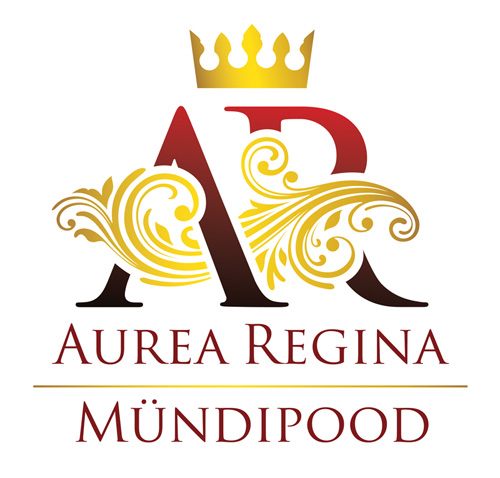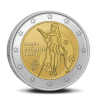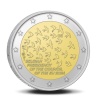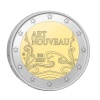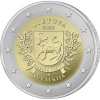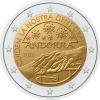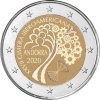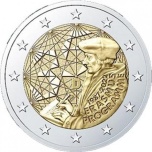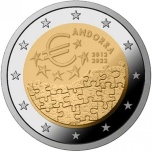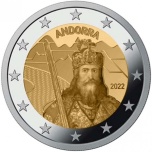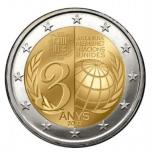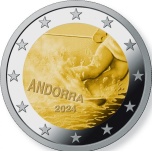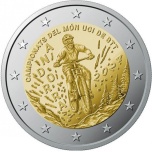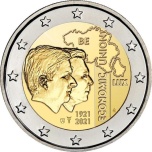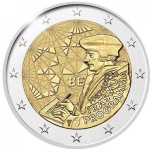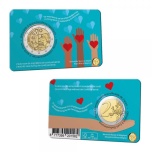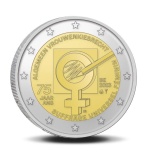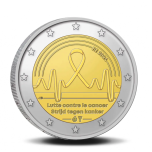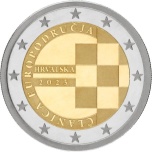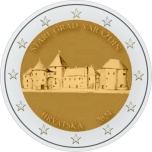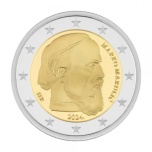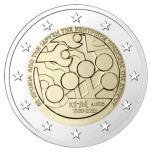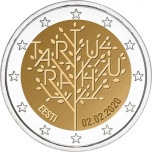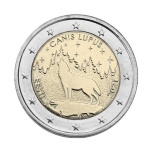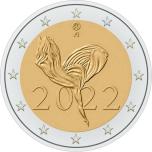2 € commemorative coins
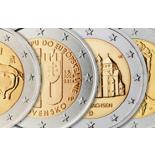
Each country may issue two commemorative coins per year. These coins have the same features and properties and the same common side as normal €2 coins. What makes them different is their commemorative design on the national side. Only the €2 denomination can be used for commemorative coins.
They are legal tender throughout the euro area. That means they can be used – and must be accepted – just like any other euro coin.
Most of these coins commemorate the anniversaries of historical events or draw attention to current events of historic importance. The very first €2 commemorative coin was issued by Greece to commemorate the Olympic Games in Athens in 2004.
Designing and issuing the coins is the competence of the individual euro countries. The ECB’s role regarding the commemorative but also all other coins is to approve the maximum volumes of coins that the individual countries may issue.

Subcategories
Feature: 35 years of the Erasmus programme
Description: The design is a mix of two major elements of the Erasmus programme: the original intellectual inspiration, Erasmus himself, and the allegory of its influence over Europe. The first one is symbolised by one of the most known depiction of Erasmus. The second one is symbolised by a beam of links going across the coin from a beacon to another, representing the numerous intellectual and human exchanges between the European students. As a reference to Europe, some of these links form other stars, born from the synergy between the countries. The figure 35, for 35th anniversary comes out from the stars in a contemporary graphical style. The coin’s outer ring bears the 12 stars of the European flag.
Issuing volume: 17 000 000
Issuing date: 1 July 2022
Kirjeldus: 27. Ibero-Ameerika riigipeade ja valitsusjuhtide tippkohtumine peetakse 2020. aastal Andorra Vürstiriigis. Andorra, mis on Ibero-Ameerika konverentsi uusim ja kõige väikseim liige, on selle kõrgetasemelise poliitilise kohtumise korraldaja. Kohtumisel osalevad 19 Ladina-Ameerika riiki ning Hispaania, Portugal ja Andorra. Kohtimisel arutatakse ühiste eesmärkide (nt kestlik areng) saavutamist. Mündil on kujutatud puu, mis koosneb inimsiluettidest ja tillukestest hammasratastest. Inimsiluetid sümboliseerivad ühiskonna lõimumist, kultuuri ja haridust kestliku tuleviku saavutamiseks. Tillukesed hammasrattad sümboliseerivad tippkohtumisel osalejate ideede ja ettepanekute vahetamisest tekkivat sünergiat. Puu kõrval on kujutatud 27. tippkohtumise logo. Logo ülemisel poolel kujutatud kolm kolmnurka sümboliseerivad Andorra lipu värve. Logo alumisel poolel kujutatud kuus kolmnurka sümboliseerivad Andorra avatust kestliku arengu eesmärkidele. Kujutise ümber on kiri „XXVII CIMERA IBEROAMERICANA ANDORRA 2020” (27. Ibero-Ameerika tippkohtumine, Andorra 2020). Mündi välisringil on kujutatud Euroopa Liidu lipu 12 tähte.
Emissiooni maht: 73 500 münti
Emissiooni aeg: 2020.
Description: The different shapes and sizes of the puzzle pieces depicted in the lower part of the design symbolize the Principality of Andorra and the countries belonging to the European Union. In the upper part of the design, the stars encircling the symbol of the common European currency represent that they are all part of the euro universe. Next to them, the name of the issuing country ‘ANDORRA’ and the years of the commemoration ‘2012’ and ‘2022’ are featured. The coin’s outer ring bears the 12 stars of the European flag.
Issuing volume: 70 000 coins
Issuing date: Fourth quarter 2022
Description: Legend has it that Emperor Charlemagne was the founder of Andorra in the year 805 and that he granted its inhabitants their own legal status. The design of the coin represents this legend deeply rooted in the history and culture of Andorra and shows, in its background, a landscape with mountains and a river, representing the rich scenery of our country, with the name of the issuing country ‘ANDORRA’. The foreground of the design depicts a partial reproduction of the well-known portrait of Emperor Charlemagne by the artist Albrecht Dürer and the year of issue ‘2022’. The coin’s outer ring bears the 12 stars of the European flag.
Issuing volume: 70 000 coins
Issuing date: Fourth quarter 2022
Description: The United Nations is represented by two symbolic elements: two laurel wreaths and a globe, which forms part of the number 30 that has been represented, with the inscription ANYS (years) and the year date 2023 below. In the upper part of the design there is the coat of arms of Andorra and the inscription ‘ANDORRA MEMBRE DE LES NACIONS UNIDES’ (Andorra member of the United Nations). The coin’s outer ring bears the 12 stars of the European flag.
Issuing volume: 70 000 coins
Issuing date: Last quarter of 2023
Description: It is considered that the first contacts of the Andorran population with skiing took place in 1924. Nowadays, skiing is the country's king of sports making Andorra a very popular destination thanks to its snow-capped mountains, spectacular landscapes and world-class ski resorts. The design of the coin commemorates the centenary of the practice of this sport in Andorra and reproduces the lower part of the silhouette of a skier together with the name of the issuing country ‘ANDORRA’ and the year of issue ‘2024’. The coin’s outer ring bears the 12 stars of the European flag.
Issuing volume: 60 000 coins
Description: This year, Andorra will host an important international sporting event: the UCI Mountain Bike World Championships 2024. The design of the coin shows a rider passing through a landscape showing the spectacular nature of this sport, with the inscription ‘CAMPIONATS DEL MÓN UCI DE BTT’ (UCI Mountain Bike World Championships 2024). The inscriptions of the issuing country ‘ANDORRA’ and the year of issuance ‘2024’ have been reproduced at the sides of the rider, as if they were another element of this sport. The coin’s outer ring bears the 12 stars of the European flag.
Issuing volume: 60 000 coins
Description: The national side of the coin features the effigy of the Belgian King Philip I and that of Grand Duke Henri of Luxembourg. In addition, both countries are depicted, with the mention of the Economic Union, and the years 1921 and 2021. As the Royal Dutch Mint will strike the coins, the mintmark of Utrecht, a mercury staff is located on the bottom together with the Belgian mint director mintmark, the coat of arms of the municipality Herzele. It also contains the initials LL, referring to the designer of the coin, Mr. Luc Luycx. The coin’s outer ring bears the 12 stars of the European flag.
Issuing volume: 155 000 coins
Issuing date: Summer 2021
Description: The design is a mix of two major elements of the Erasmus programme: the original intellectual inspiration, Erasmus himself, and the allegory of its influence over Europe. The first one is symbolised by one of the most known depiction of Erasmus. The second one is symbolised by a beam of links going across the coin from a beacon to another, representing the numerous intellectual and human exchanges between the European students. As a reference to Europe, some of these links form other stars, born from the synergy between the countries. The figure 35, for 35th anniversary comes out from the stars in a contemporary graphical style. The coin’s outer ring bears the 12 stars of the European flag.
Issuing volume: 150 000 coin card
Issuing date: 1 July 2022
Description: The design depicts in the inner part of the coin the health personnel. At the left you can find the inscription ‘Danke – Merci – Dank u’ together with various pictograms referring to healthcare sector. From top to bottom, a cross, a stethoscope, a heart, a syringe, a wheelchair and a chemical mixture are shown. At the far right are the initials of the designer Luc Luycx located. As the Royal Dutch Mint will strike the coins, the mintmark of Utrecht, a mercury staff is located on the bottom together with the Belgian mint master mark, the coat of arms of the municipality Herzele, the country code BE and the year mark 2022. The coin’s outer ring bears the 12 stars of the European flag.
Issuing volume: 2 000 000 coins
Issuing date: Spring 2022
Feature:
Issuing volume: 125 000 coins
Description: The design shows in the centre a ribbon, which is used as a universal symbol to express engagement in the fight against cancer. The shape of the ribbon extends further along the two sides in curved lines, symbolising the movement of a heartbeat on a monitor, as an expression of life and vitality. Three lines can be seen at the top, as a reference to a rainbow (symbolising hope and consolation). Inserted in the bottom line is the country code BE and the year 2024. In the lower part of the piece are inscriptions in French and Dutch: 'Lutte contre le cancer' - 'Strijd tegen kanker'. The initials of the designer Iris Bruijns are located on the left side above the inscriptions. As the Royal Dutch Mint will strike the coins, the mintmark of Utrecht, a mercury staff is located at the very bottom of the piece, together with the Belgian mint director mintmark, an aster flower in front of an Erlenmeyer flask. The coin’s outer ring bears the 12 stars of the European flag.
Issuing volume: 2 130 000 coins
The sky is slowly clearing
In recent years, science has made spectacular advances in the fight against cancer, increasing survival rates and extending lifespans. Although a diagnosis can be particularly harsh and the road to a cure can be quite tough, we should certainly not lose heart. More than ever, we must dare to take a positive approach to confronting cancer. Here, not only the specific input of the oncologist, but also the support of the psychologist and physiotherapist plays an invaluable role. Without forgetting the precious help of the caregiver or volunteer, of course.
Mintage: 125 000 coin card
Issuing volume: 150 000 coins
Description: The design features the inscriptions of the issuing country ‘HRVATSKA’ (Croatia) and the year of issuance ‘2023.’, depicted horizontally, as well as the words ‘ČLANICA EUROPODRUČJA’ (member of the euro area), which are inscribed along the outer edge of the coin’s core. These inscriptions symbolically form a stylised symbol of the euro ‘€’. The other central motive of the coin is Croatia's distinctive and recognisable symbol, the Croatian checkerboard, which represents part of the coat of arms of the Republic of Croatia. The coin’s outer ring bears the 12 stars of the European flag.
Issuing volume: 250 000 coins
Description: The design features the keep of the Varaždin Castle (12th – 16th century). Varaždin is first mentioned in 1181. Having suffered massive casualties in the Tatar invasion of 1242, it was built as a royal fortress, which would become known as the Old Town. Its appearance has changed through the centuries: from a strong medieval fortress surrounded by water-filled moats to the main fortress and armoury of Slavonian Military Border and Varaždin military headquarters and a beautiful Renaissance castle. At present, the Old Town is the most important and magnificent historical building of the City of Varaždin, a highest-category monument of the Croatian architectural heritage. The coin also features the name of the issuing country ‘HRVATSKA’ (Croatia), the year of issuance ‘2024’, and the words ‘STARI GRAD VARAŽDIN’ (the Old Town of Varaždin), which are all inscribed circularly at the top and the bottom of the design. The coin’s outer ring bears the 12 stars of the European flag.
Issuing volume: 200 000 coins
Description: In recognition of this significant milestone, the Government of the Republic of Croatia has proclaimed 2024 as the Year of Marko Marulić. The central motif of the national side of the coin is the portrait of Marko Marulić (1450-1524), Croatian writer. Marko Marulić (Marul) was born in Split in 1450 and is a prominent representative of European Christian humanism and Renaissance epics. His literary works, mostly written in Latin, are comprised of works in verse and prose, his literary models being the Bible, the Church Fathers' philosophy and classical antiquity. He wrote the epic poem Judita, his magnum opus, in Croatian. It is the first artistic epic in Croatian literature composed in the Croatian language to contain the underlying poetics of Virgil and the Biblical epics. In it, Marulić achieved a true Renaissance synthesis of Croatian, Latin and Italian literary tradition, thus creating a masterpiece. Completed in 1501, it was first published twenty years later. The coin also features the inscriptions of the two-letter issuing country code "HR" (Croatia), the year of issuance "2024." and the words "MARKO MARULIĆ", which are all inscribed circularly along the edge of the coin's core. The coin’s outer ring bears the 12 stars of the European flag.
Issuing volume: 200 000 coins
Description: The design depicts tools on a microchip symbolising the stability of the economy in the modern industrial and digital era secured by the Central Bank of Cyprus, which celebrates 60 years of existence. The issuing country's name ‘ΚYΠΡΟΣ KIBRIS’ and the dates ‘1963-2023’ are at the bottom. Additionally, the phrase ‘60 ΧΡOΝΙΑ ΑΠO ΤΗΝ IΔΡΥΣΗ ΤΗΣ ΚΕΝΤΡΙKHΣ ΤΡAΠΕΖΑΣ ΤΗΣ ΚYΠΡΟΥ’ (i.e. 60 years since the foundation of the Central Bank of Cyprus) is inscribed on the inner part of the national side of the coin. The coin’s outer ring bears the 12 stars of the European flag.
Issuing volume: 412 000 coins
Description: The treaty was signed between Estonia and Soviet Russia on 2 February 1920, and it fixed the Eastern border of Estonia, bringing an end to the War of Independence. The design depicts a tree with branches disguising the words TARTU RAHU (Tartu Peace Treaty). It also bears the country name ‘EESTI’ and the date of issue ‘2 February 2020’. The coin’s outer ring bears the 12 stars of the European flag.
Issuing volume: 1 000 000 coins
Issuing date: February 2020
Description: The design depicts the silhouette of the wolf and a forest. Close to the edge of the inner ring the country name ‘EESTI’ at the left, the year of issuance ‘2021’ at the right and the text ‘CANIS LUPUS’ (the wolf in Latin) at the top are depicted.
Issuing volume: 1 000 000 coins
Issuing date: Autumn 2021
Description: The design depicts the powerful and free movements of a dancer covered in a light flowing textile that accentuates the beauty and fluidity of the dancer's pose. It also bears the year of issuance ‘2022’ and at the top the indication of the issuing country ‘FI’ and the mintmark. The coin’s outer ring bears the 12 stars of the European flag.
Issuing volume: 400 000 coins
Issuing date: Spring 2022
